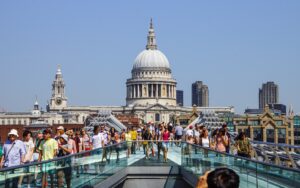human induced vibration
Why engineers must consider human induced vibration

Human footfall can cause vibrations throughout structures and buildings. While this may sound concerning and have us thinking of Millennium Bridge-style swaying or unsafe constructions, the most effect human induced vibrations have is making others in the building feel uncomfortable. While this might not sound like a major concern, engineers want to ensure their structures are safe and comfortable for those passing through.
In this article, structural, geotechnical, and pedestrian analysis software developer, Oasys, looks at the potential impacts of human induced vibration and how to remedy the risk.
Two types of vibrations
 There are two types of human induced vibrations: resonant and impulse or transient response.
There are two types of human induced vibrations: resonant and impulse or transient response.
In simple terms, resonance occurs when Object A vibrates at the same natural frequency as Object B. Object B resonates with this and begins to vibrate too. Think singing to break a wine glass! Although the person singing isn’t touching the glass, the vibrations of their voice are resonating with the glass’s natural frequency, causing this vibration to get stronger and stronger and eventually, break the glass. In the case of a structure, resonance occurs when the pedestrian’s feet land in time with the vibration.
Impulse or transient vibration responses can be a problem on structures where its natural frequencies are too high for resonance to occur, such as where the structure is light or stiff. Here the discomfort is caused by the initial “bounce” of the structure caused by the footstep and is a concern on light or stiff structures.
So, engineers design to reduce the vibration effects caused by either impulse or resonance.
Potential impacts of human induced vibration
Effects of human induced vibration upon the structure and its users include:
- Impacting sensitive equipment. Depending on the building’s purpose, what it houses can be affected by the vibrations of people using the building. Universities and laboratories, for example, may have sensitive equipment whose accuracy and performance could be damaged by vibrations. Even in ordinary offices the footfall vibration can wobble computer screens, upsetting the workers.
- Causing bridges to sway. One of the most famous examples of human-induced resonance impacting a structure occurred with the Millennium Bridge. As people walked across the bridge, the footsteps caused the bridge to sway, and everybody had to walk in time with the sway because it was difficult not to. Thankfully, this feedback can only occur with horizontal vibrations so building floors are safe from it, but footbridges need careful checking to prevent it.
- Discomfort in users. According to research, vibrations in buildings and structures can cause depression and even motion sickness in inhabitants. Tall buildings sway in the wind and footsteps can be felt, even subconsciously by the occupants. It has been argued that modern efficient designs featuring thinner floor slabs and wider spacing in column design mean that these new builds are not as effective at dampening vibrations as older buildings are.
- Risking the integrity of the structure. The build-up of constant vibrations on a structure can, eventually, lead to structural integrity being compromised. A worse-case scenario would be the complete collapse of the structure and is the reason some bridges insist that marching troops break step before crossing. Crowds jumping in time to music or in response to a goal in a stadium are also dynamic loads that might damage an under-designed structure.
Remedying the risk of human induced vibration
As discussed, modern designs that favour thinner slabs and wider column spacing are particularly susceptible to all forms of vibration, human-induced or otherwise, but short spans can also suffer due to their low mass. Using sophisticated structural analysis software is an effective method for engineers to test for and mitigate footfall and other vibrations at the design stage.
Sources:
Approaches to managing the risks associated Musculoskeletal disorders
In this episode of the Safety & Health Podcast, we hear from Matt Birtles, Principal Ergonomics Consultant at HSE’s Science and Research Centre, about the different approaches to managing the risks associated with Musculoskeletal disorders.
Matt, an ergonomics and human factors expert, shares his thoughts on why MSDs are important, the various prevalent rates across the UK, what you can do within your own organisation and the Risk Management process surrounding MSD’s.
Why engineers must consider human induced vibration
Human footfall can cause vibrations throughout structures and buildings. This article looks at the potential impacts of human induced vibration and how to remedy the risk.
Safety & Health Practitioner
SHP - Health and Safety News, Legislation, PPE, CPD and Resources Related Topics
Hundreds of workplace buildings to be inspected for safety this week
Tackling exposure to airborne contaminants through exhaust ventilation
Manufacturer fined after failing to manage workers’ exposure to vibration

 There are two types of human induced vibrations: resonant and impulse or transient response.
There are two types of human induced vibrations: resonant and impulse or transient response.